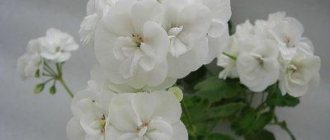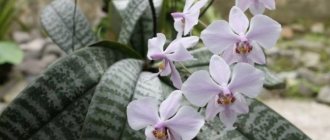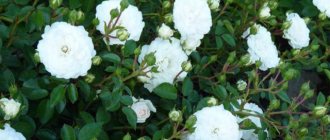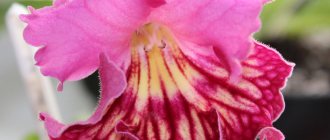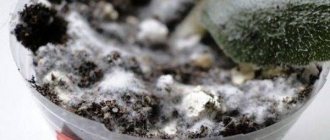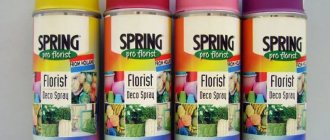A plant with a magnificent appearance, and therefore a real favorite among gardeners, is geranium or, more scientifically, royal pelargonium. This is a flower native to South America. It came to Europe in the 18th century, and since then, breeders have developed many different varieties, differing in appearance and characteristics.
Description
Pelargonium royale as a botanical species is called grandiflora and belongs to the Geraniaceae family.
Interesting fact: Geranium and pelargonium are different plants, but very often, when flower growers call a flower geranium, they mean pelargonium.
The pelargonium bush is small in size and reaches up to 60 cm. The stems are herbaceous, erect, completely covered with dark green leaves with a rough surface and a small fluff. The plant is distinguished by large inflorescences, which, with good care, can be up to 25 cm in diameter. It is for this reason that pelargonium is valued.
Pelargonium Mona Lisa
One flower is approximately 5-7 cm in diameter, the petals located on top are superimposed like a fan on the lower ones, while their color and shape are varied: they can be lilac, violet, white or painted in almost any shade of red. One bud can include several contrasting tones. The shape of the flowers is regular and double (most often), with corrugated, smooth or wavy edges, and practically no smell.
Pelargonium Pink Mikado
Pelargonium Regal looks equally beautiful in a pot on the wall or displayed on a windowsill. During the summer months, the plant is often planted on the balcony. With proper care and feeding, royal pelargonium blooms within three to four months. Other types of geraniums bloom much longer; in order to achieve the same from the queen, constant pruning of dried buds and the application of mineral fertilizers, which include phosphorus and potassium, are needed. As a means of extending the flowering period, grafting of royal pelargonium onto other varieties of this flower is used.
Pelargonium Regal
Types, names and photos
The species diversity of pelargonium is enormous. On our website we have already talked about the following representatives of the beautiful flower: Fragrant, Ampelous, Ivy-leaved, Tulip-shaped, Variegated, Yellow, Star-shaped, Prince Gustav, Clara San, Patricia Andrea.
Orange
Belongs to the carnation group. Bush 30 cm high, profusely flowering. The color of the buds ranges from light orange to salmon. The variety is unpretentious, but prefers to be located in partial shade . Quickly adapts to environmental conditions.
Ice Rose
Ivy-leaved variety of pelargonium (ampeloid form with hanging or creeping shoots) with white double flowers. The plant has short internodes and a compact bush. The variety is profusely flowering.
Ice Rose pelargonium flowers are very large, up to 6 cm in diameter . The edges of the petals are fringed, the flowers are densely double, shaped like a rose.
A characteristic feature of this variety is the light lilac tint of the foliage if the flower grows in a sunny place.
Unique
This variety is the result of crossing the royal and brilliant pelargonium. And despite the fact that this group appeared in the second half of the 18th century, you can rarely find it in modern flower beds. The flowers are somewhat smaller than the Royal one, but the foliage is more decorative and in most cases has a pleasant aroma.
Irida Confetti
Belongs to the group of zonal pelargonium. The bush is compact and neat. The flowers are pale pink with fuchsia strokes closer to the center. The buds are collected in lush inflorescences. The foliage is medium in size, carved. Irida Confetti is sensitive to fertilizing and thrives on sunny windowsills.
Mini Diana
Golden leaf zonal miniature pelargonium. Blooms often and abundantly. The bush is very compact. The flowers are white, with a pinkish tint, semi-double, and quite large. The leaves are light green with a brown zone in the center of the leaf. The variety is unpretentious. After planting the cuttings, it grows slowly and gains green mass.
Diana Palmer
Belongs to the group of zonal, carnation-flowered pelargoniums. The bush is neat and blooms profusely. After pruning it produces abundant growth . The flowers are large, double, orange with white shading. The edges of the petals are serrated. The variety is not whimsical.
In winter, fertilizing is required.
Natalie
Semi-double dwarf zonal pelargonium. The bush is compact and grows slowly. Flowers with 9 petals are pearl pink with a white border around the edge. The first flowers are 3-4 cm in diameter. With age, it produces buds up to 5 cm in diameter. There is little foliage on the bush; in hot weather it can shed it. The variety is quite capricious to care for.
Powder Poof
Dwarf zonal pelargonium, double flowers, light salmon color. The bush is compact. The plant gains weight slowly and reluctantly produces lateral shoots when pruned. Leaves in good light with a clear dark zone.
According to reviews of many gardeners, it blooms infrequently and not abundantly, although the authors declare it to be a profusely flowering variety . The situation can be corrected with proper feeding.
Bornholm
Belongs to the group of zonal pink-flowered pelargoniums. A distinctive feature of the variety is its beautiful rich green leaves with white veins. Large, heavily double rose flowers of bright red color. Blooms profusely, with dense caps.
Albina
This is a zonal dwarf variety. The variety is unpretentious. Blooms profusely. The color of the petals is snow-white and they do not change their shade in the sun, which makes this variety even more valuable among gardeners. Flowers up to 3.5 cm in diameter, double, collected in dense inflorescences. The foliage is deep green.
Elmset
Belongs to the group of dwarf zonal speckled pelargoniums. This variety blooms almost constantly. The flowers are amazingly decorative. The petals are a soft pink shade with specks and strokes of rich pink color. In the sun, the color of the petals becomes more saturated .
Dovepoint
Dwarf pelargonium with large, densely double flowers collected in dense inflorescences. Petals are pale pink, waxy. It grows quickly and to prevent the stems from stretching, pruning is recommended. The foliage is rich green with a darker zone around the edges.
Crown Princess Mary
Group of zonal terry pelargoniums. The variety is profusely flowering. The inflorescences do not even form into hats, but into balls of snow-white flowers with a greenish center. As it blooms, a slight pinkish tint may appear. The bush is compact and neat.
Princess Sandra
The plant belongs to the group of zonal terry pelargoniums. The bush is quite large, can reach a height of 30-40 cm. The variety lends itself well to shaping and blooms profusely . The flowers are very decorative, fancy in color. Shades of crimson are combined with soft pink, white and fuchsia shades. The color of the foliage is uniform, rich green.
Passat
Zonal terry, very decorative pelargonium. The flowers are pale pink, densely double, arranged in dense caps on long peduncles. The variety blooms profusely and often, for which it has earned the love and recognition of flower growers.
Peppermint Twist
Zonal terry pelargonium. It blooms profusely, with large semi-double flowers of a peach-pink hue with speckles of red and crimson. The peduncles are long and cannot always hold large, dense inflorescences vertically. The leaves are green with a distinct brown zone. The bush is standard. The height of the plant can reach 40 cm. The variety is unpretentious and can be easily molded.
Lake
Belongs to the type of zonal pelargonium. The bush is small and compact. The flowers are double, watercolor salmon color in the center and a lighter shade closer to the edge. In the sun, the shade of the petals becomes more saturated , and the transition from color to color is more pronounced. The darker zone is clearly visible on the leaves. The variety requires pruning and shaping.
Bronze Butterfly
Star-shaped double pelargonium with coral-colored flowers. The flowers are unusual, very decorative. The variety is docile and lends itself well to shaping.
A distinctive feature is the leaves, which in bright sun can acquire a bronze tint.
Magnus
Zonal terry variety of pelargonium. The color of the petals varies from blood red to black-red. The petals are velvety, very delicate. Easily damaged by the sun. The variety is sensitive to environmental conditions . According to reviews from breeders, he is very capricious. With proper care it shows lush flowering.
Royal pelargonium
Or they also call her royal. It justifies its name not only by its high decorativeness of both flowers and leaves, but also by its high care requirements. The bush reaches a height of 50-60 cm. The flowering is lush and abundant. The inflorescences are huge, in a wide variety of colors and shades. A distinctive feature of this variety of pelargonium is the folded, carved leaves with a rough surface and a jagged edge.
Tamara
The bush is compact and neat. The foliage is lush green in color and small to medium in size. Delicate pink double flowers with lilac veins in the center, tightly collected in inflorescences and reminiscent of a marshmallow cloud.
According to reviews from breeders, the color of the petals is changeable and can vary by several shades depending on the conditions of detention and the flowering season.
Red
It is this type that can most often be seen on the windowsills of not professional breeders, but connoisseurs of unpretentious beauty. The plant is easily propagated by cuttings and branches well when pruned . The flowering cannot be called abundant, but if you periodically fertilize, you can get bright red caps of five-petaled flowers.
Maverick white-pink
Belongs to the well-known Maverick series. Like most of its representatives, the plant is characterized by its small size, compact shape and lush flowering. It grows quickly and responds well to growth stimulants.
The variety is quite obedient and easy to shape . The leaves are green and monochromatic. The flowers are pale pink, almost white with a deep pink center. The plant tolerates heat well, the flowers last a long time, creating the feeling of constant abundant flowering.
Tuscany
Popular series of zonal pelargoniums. The entire series is characterized by compactness of the bush, abundance of flowering and high density of inflorescences. Peduncles are usually not very long. When flowering, it seems that the caps of inflorescences lie directly on a cushion of green foliage.
Tuscany Bernd
A popular representative of the Tuscany series. Dwarf form, so the plant is compact and neat. The leaves are rich green, dense. The flowers are semi-double, bright red, sometimes with a light white streak at the center.
A distinctive feature of this variety is that when flowering occurs, the red pigment disappears from the tips of the leaves. The petals become whitish at the edges, as if covered with frost.
Tuscany Hero
Semi-double zonal pelargonium. The bush is compact, blooms lush. The flowers are simple, large, deep red, with a lighter center and edges. The variety is unpretentious in care; when fertilized, it blooms almost constantly .
apple blossom
Belongs to the group of zonal pelargoniums. The height of the bush is 35 cm. The leaves are dark green, almost brown with a lighter border along the edge. Flowers of a delicate white-pink hue are collected in lush caps. During the season, 50-60 inflorescences grow. It can bloom all year long with proper care. The variety is unpretentious and easily adapts to changes in growing conditions. Loves sunny places, but tolerates partial shade.
Black velvet
This is one of the popular professional series of pelargoniums. Often grown from seeds. The height of the bush is up to 40 cm. A distinctive feature of the series is considered to be leaves with a characteristic dark (almost chocolate) leaf color. The color of the petals in the varieties of the Black Velvet series varies from pronounced pink to bright red and salmon.
Hybrid
Large-flowered hybrid pelargonium is a subshrub with quickly hardening shoots . Leaves without a dark zone, slightly lobed, with pronounced teeth along the edge and with a weak aroma on the leaves. The color of the flowers is red, pink or white, with darker spots on the petals. The inflorescences are umbrella-shaped, located on long strong peduncles.
Among gardeners, pelargonium is known for its wide variety of varieties. On our portal you can also get acquainted with the following varieties of this amazing flower: Red Pandora, Denise, Anita, Mildfield Rose, Richard Hudson, Zonartik, Bold, Grandiflora, Pink, Salmon.
Pelargonium hybrids
Prominent representatives of pelargonium hybrids include varieties such as:
- Sophie Arden;
- Norland;
- Arctic Star.
Sophie Arden
Terry zonal pelargonium. Blooms profusely with dense pink flowers. The inflorescences are dense, umbrella-shaped. The plant lends itself well to shaping.
Norland
Terry zonal pelargonium. A variety with large leaves and large buds. Tolerates partial shade well, does not like heat . Plants bloom often and abundantly.
Arctic Star
Star-shaped variety with snow-white flowers. The inflorescences are not very dense. The foliage is abundant and deep green.
Scarlet Knight
The bush is compact, up to 40 cm high. The foliage is abundant, almost brown with a green border. The inflorescences are spherical, collected from flowers of a rich red hue. The petals are round with a white underside. It doesn't bloom very profusely. Loves sunny places, responds well to watering with growth stimulants .
Madam
Another popular variety series. Plants belonging to it are characterized by compactness of the bush, decorative leaves, good survival rate and rapid adaptation to growing conditions.
Madame Bovary
This representative of the “Madame” series belongs to the group of double zonal pelargoniums. The bush is compact, the foliage is plentiful, medium in size, with a pronounced dark zone. The flowers are deep red. It does not produce flower stalks often, the inflorescences are not large and not dense. After pruning, it quickly sprouts new growth.
Madame Celeron
The variety is decorative - deciduous. Never blooms. The foliage is characterized by silver variegation. It is sometimes confused with the Little Trot variety, which produces peduncles with lilac-pink flowers. Another feature of the Madame Celeron variety is that its leaves do not have a bitter odor .
Fisher Appleblossom
Belongs to the group of rosebud pelargoniums. The flowers are a soft pink hue with brighter flashes along the edges of the petals, shaped like roses. The buds are collected in dense inflorescences. A leaf with a pronounced dark zone. The bush is large and without shaping it is not very neat.
Blue
Pelargoniums with blue flowers are quite rare. More often, petals of various shades of blue can be found in garden varieties (Himalayan, Georgian, Magnificent, etc.). These plants are native to mountainous areas, so they tolerate fairly low temperatures and drought .
Miniature
These babies are perfect for those who have limited space to place flower pots. Now these varieties of pelargoniums with compact bushes and beautiful inflorescences are gaining more and more popularity among gardeners. Their care is specific due to their small size. Among the most popular varieties in this category:
- Francis Parrett;
- Pink Ice;
- Ludwigsburger fleur;
- Brookside fantasy.
Find out more nuances about dwarf pelargoniums.
Varieties
Breeders have bred many varieties of royal pelargonium, but only a few of them are especially loved by flower growers:
- Pink Mikado - the flowers are very large, pink, the petals have a wavy edge.
- Carisbrooke - plants with light pink flowers, on the upper petals a marbled pattern in the form of streaks and spots.
- Nellie - wavy petals, dark red and white, semi-double flowers.
- Aristo Schoko - the flowers are large, with very dark petals (red, almost black), along their edge there is a border that is one or two shades lighter than the main color.
- Sally Munro - the variety is capable of blooming several times per season, is distinguished by large flowers, the lower petals are pinkish, the upper ones are dark red.
- Mona Lisa - plants with large white flowers with pink stamens, petals with wavy edges.
Pelargonium Mona Lisa
Home care
Royal pelargonium is a rather demanding plant in terms of growing conditions, and growing it at home is not an easy task. Violation of the rules of care is fraught with the cessation of flowering. The flower does not grow well in the shade, and direct sunlight leads to burns on the delicate velvety leaves. Insufficient and excessive watering have equally detrimental effects on the condition of the plant.
Pelargonium Sally Munro
Illumination. If the plant receives enough light, the flowering will be long and abundant. The flowerpot can be placed on the windowsill of a window facing south, but it is necessary to protect the flower from direct rays of the sun.
Advice During the winter months, add light to the plant using phytolamps. This will prevent the stems from stretching due to lack of light.
Temperature conditions. In summer, the thermometer in the room where the royal pelargonium is located should not rise above +24° C. In winter, the flower is in a dormant state, for which the optimal regime will be from +12 to +15° C. Draft is unacceptable. If you neglect these rules, pelargonium will not bloom.
Pelargonium Carisbrooke
Humidity. This indicator is not very important. Pelargonium tolerates dry and humid atmospheres well, but when spraying (if the air in the room is very dry), it is necessary to avoid getting droplets of water on the flowers and leaves.
Advice Pelargonium loves fresh air, so in the summer be sure to take it outside or onto the balcony. This will ensure an excellent appearance of the plant, longer and more abundant flowering.
Watering. In the summer months, royal pelargonium needs to be watered generously twice a week; if it is hot, this should be done every other day, and in some cases daily. The main criterion by which the need for watering is determined is the dried top layer of soil.
Pelargonium Nellie
Miss Clean magazine recommends watering the plant with well-settled water (at least 12 hours), not in a flowerpot, but in a tray. Boiled water will do. Feeding. In spring and summer, when the plant blooms, it is necessary to apply complex mineral fertilizers with a high content of phosphorus and potassium once every two weeks. This will extend the flowering period by several weeks. Royal pelargonium will like fertilizers designed specifically for indoor plants, for example, “For flower plants” or “Merry flower girl”. If there is too much nitrogen in the complex fertilizer, then the stems and leaves will grow well, and fewer buds will form. There is no need to fertilize in winter.
Pelargonium Aristo Schoko
Priming. It is necessary to place a drainage layer at the bottom of the pot, which will ensure the removal of excess liquid, preventing stagnation of water. The substrate must have a slightly alkaline or neutral reaction.
Advice: Ordinary ash will help reduce acidity - pour a little of it into a flowerpot. In addition to the alkalizing effect, ash will be a good fertilizer.
Proper care ensures that royal pelargonium blooms for several months every year.
We recommend: Mother-in-law's tongue, or Sansevieria - a convenient flower for beginner gardeners
General rules of care
Caring for pelargonium is very simple. Even a beginner in floriculture can handle it. Here are a few key points to know :
- Pelargonium prefers well-lit places.
- Propagated by cuttings and seeds.
- Most varieties require additional bush formation. Pinch out plants at the end of winter.
- In spring and summer, watering is plentiful, but with the onset of the winter season, watering is reduced.
- For lush flowering, regular feeding is carried out. Fertilizers containing phosphorus stimulate the formation of buds.
Also on our website we have prepared for you a number of articles with descriptions and recommendations for growing and caring for the following varieties of pelargonium: Australian Rosebud, Silk, Angel, Pak, Viva, Rococo, Stellar, April Snow, Lady Gertrude.
The species diversity of varietal pelargoniums is amazing. Anyone who wants to place an unpretentious, long-lasting and profusely blooming flower on their windowsill will be able to find it among the varietal range of pelargonium. Breeders have even found a solution for those who do not like the bitter smell of the leaves. Varieties have appeared with distinct aroma notes of citrus, peach, chocolate and even perfume.
Reproduction and transplantation
Royal pelargonium is most often propagated by cuttings, since seeds are not easy to find even in online stores. In addition, the characteristics of the terry nature of the most beautiful flowers are not transmitted through seed propagation. The best period to root cuttings of royal pelargonium is September and August, but this can be done all year round.
Cut the cutting at an angle of 45 degrees, 5 mm below the internodes; for dwarf and small plants its length should be approximately 5 cm, for large, tall plants - 10 cm. Remove the lower leaves and buds from the shoots, leaving only the top three. Sprinkle the cutting area with charcoal (crushed) and let the cutting lie in the air for 18 to 24 hours.
Let's assume another method of rooting. 10 minutes after the cutting was cut from the bush, carry out the following activities:
- treat the cuttings with root;
- plant in a mixture consisting of peat, humus and sand or in wet peat tablets;
- cover with non-woven cloth for three days.
Cuttings should not be placed in ordinary water for rooting: they will rot or not sprout roots. Young sprouts need moderate watering, as they are sensitive to excess moisture.
Advice: Water the planted cuttings with phytosporin. This technique will prevent the development of rot on the cuts.
Rooting should occur at a temperature of +19 to +23° C. The roots will appear in a maximum of 12 weeks, after which plant the cuttings in a pot where the plant will be grown permanently. Above the third pair of leaves, pinch the main stem, this will ensure the growth of new side shoots. With proper care of young plants, the first inflorescences will appear next spring.
The aerial part grows at a very fast pace in all pelargoniums, regardless of the species. Over the summer, with good care, the bush and roots will noticeably lengthen. If, when removing the earthen lump from the pot, it is clear that the roots have completely entwined the soil, then replant the pelargonium in February. The soil should retain moisture, have excellent air permeability and be loose. The ideal soil mixture would be sand, garden soil and peat taken in equal parts.
We recommend: Is it possible to replant an orchid when it blooms?
Stagnation of water in a pot provokes root rot; to prevent this problem from occurring, place a thick layer of drainage on the bottom of the container.
Advice Do not plant royal pelargonium in containers that are too wide, otherwise the buds may not appear. The fact is that in a large pot, pelargonium actively grows green mass.
Pelargoniums fragrant and tulip-shaped
P. Robert's Lemon Rose
My passion for pelargoniums began in the spring of 2016, when I saw photographs of tulip-shaped pelargoniums from a wonderful collector. I liked these miniature bouquets of not fully opened flowers so much that I decided to buy myself a couple.
Red Pandora
Buds
buds
Pink Pandora
I’ll say right away that I destroyed almost all the tulips. At first, someone started eating them. I treated them with actara, and the situation seemed to improve. But the leaves continued to deteriorate and the trunks became bald. None of the tulips survived the winter because it was too hot for them on the windowsills.
Along the way, I selected several cuttings of fragrant pelargoniums that I liked in appearance. I really liked the Royal Oak variety, whose leaves resemble oak leaves. Royal Oak
And I really liked that a beautiful pattern appeared in the sun.
"Oak" leaves
Any pelargonium requires shaping and pruning. As a beginner, I was scared to cut up young plants. In the end, what happened was what happened. A sloppy bush with long internodes. But for the future I already know that from the very early spring it is worth paying attention to pruning.
Bush
photoshoot
All fragrant flowers bloom modestly, with small, discreet flowers. But even in them you can see tenderness, beauty and all the efforts of nature to create a masterpiece.
Royal Oak bloom
At the beginning of summer, I transferred all the cuttings from the glasses into fairly large pots. The soil mixture was made as follows: part of the universal soil, part of the Klassman TS1 peat soil, an eyeful of vermiculite (I noticed that in my conditions, pelargoniums dry out quite quickly) and an eyeful of perlite, to add airiness.
Cuttings after transplantation in a dense row on the balcony
All the cuttings responded quite willingly to the transshipment and began to develop quite actively. Another fragrant beauty is Atomic Snowflake. Again, now I see errors in the formation. But the variety as a whole is quite spread-out; the cuttings of the leaves are quite long.
Atomic Snowflake. Openwork leaves
My next purchase was Fragrant Frosty. Baby smelling like lemon. Its leaves show a clear white edge in the sun. The variety is beautiful and readily grows as a neat bush. Fragrant Frosty
Bush
And this is very similar to the previous one, Pelargonium Graveolens. Their leaf shape is quite similar, but without a white border. Their smells are insignificant, but they are different. I took it for symmetry. Graveolens
This one is also a wide-legged girl, the cuttings are very long. To hide this, you need to skillfully form the main branches. This is for the future.
Bush
In the title photo and below are Robert's Lemon Rose pelargos. What funny leaves it has, similar to the foliage of tomatoes! The flowers are modest.
P. Robert's Lemon Rose
Towards the sun
I may have been too harsh in criticizing the fragrants for their outstretched legs. I don’t dismiss the thought that my hands are growing from the wrong place. But in the end I will show you those who are definitely compact and neat.
Bush
Tulip bud
And near the school I picked ivy-leaved pelargonium - a variety that hangs like an ample from pots. The cuttings took root and bloomed on the balcony until the New Year. Ivy
One of the favorites in my modest collection is Fringed Apple. It grows as a small tree, which greatly facilitates the process of forming a bush. But the leaves are a real treasure. They are very soft, barely rough, like the most expensive velvet. It blooms very modestly and takes root quite well in the spring and summer. Fringed Apple
But my real favorites are Cy's Sunbrst and Crispum Variegatum
Cy's Sunbrst
Crispum Variegatum
The photo shows that the second variety is still a small cutting. This is because I paired it with the already existing Cy's Sunbrst, which began to grow quite quickly in the sun. I often ask my guests to guess what kind of plant it is. No one can identify them as pelargoniums. Their aroma is very strong, fruity, similar to candy. But most of all I appreciate them for two qualities: tree-shaped growth (you can easily form a trunk) and miniature leaves.
Cy's Sunbrst
They overwinter better than all my other scented plants and give good growth. Of course, they lose leaves, like all pelargoniums in a warm apartment, their shoots also stretch. But this is not as critical as with other guys. Cy's Sunbrst
When we wait until spring, I’ll trim them and try to root them. I want several pots with such beauty. I already have several wishes for spring, which I’ll try to get instead of the dead tulips. Pelargonium species are especially interesting. They are so funny, they grow very interestingly, and their blooms can be quite spectacular!
Do you have scented ones? Which one takes pride of place?
Useful tips
When growing royal pelargonium, problems most often arise with excess moisture due to excessive watering.
Recommendations from experienced flower growers will help to detect the problem in a timely manner and eliminate it:
- If the leaves located below turn yellow, the reasons may be different. The elasticity of the sheet plates does not change, but the edges dry out due to lack of moisture. Limp and rotten leaves indicate overwatering. Leaf blades that have turned yellow at the edges indicate a lack of nutrients in the soil, which systematic feeding will help replenish.
- The leaves of pelargonium turn red if it freezes, so during the cold months of the year, remove the flower pot from the windowsill and place it at a distance from the window.
- The base of the stem darkens when the flower is infected with black stalk. It will not be possible to cure this disease or save the flower; it is necessary to destroy pelargonium as soon as possible to prevent the pathogen from spreading to other indoor plants.
- The leaves fall off and the stem becomes bare when the flower is insufficiently illuminated. Most often this happens in winter. To correct the situation, illuminate the pelargonium with a phytolamp.
- Watery soft pads appear on the leaf blades under the simultaneous action of two unfavorable factors: excess moisture and lack of light. Additional illumination with a phytolamp and a reduction in the number of waterings eliminate the problem.
- Pelargonium planted in open ground will not bloom if too much fertilizer has been added to the soil or if there is extreme heat. Move the flowerpot with the flower to partial shade and water more often. Stop feeding the plant, especially if no flowers appear, but pelargonium is growing very quickly.
- A plant located indoors most often does not bloom due to lack of light, excess fertilizing, and almost the same air temperature day and night. Stop fertilizing for some time, provide additional lighting, or move the pot to a more illuminated place.
- Pelargonium buds can dry out and fall off without even opening due to excessively high air humidity and excessive watering. Reduce the frequency or amount of soil moisture and provide a drier atmosphere.



